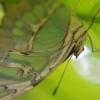1. Location of collection Found in my backyard (creek/small ammount of trees) in summerville south carolina
2. Date of collection; 5/29/2017.
3. Habitat of collection: woods/fields
4. Length: measured 8-9 mm best i can give
5. Coloration, hue, pattern and texture:. Black with an almost redish coloration lightly around head and legs it looked like.
6. Distinguishing characteristics: none i can see
7. Anything else distinctive: as soon as she was put in test tube calmed right down by cotton and attended to her gaster
8. Nest description none
9 . best pics i could get the cotton is oddly shaped so i can't get a good shot
https://gyazo.com/a3...44db9741c574ebd
https://gyazo.com/33...9dcf5f314a2aeed
https://gyazo.com/7e...40823c027191dac
















